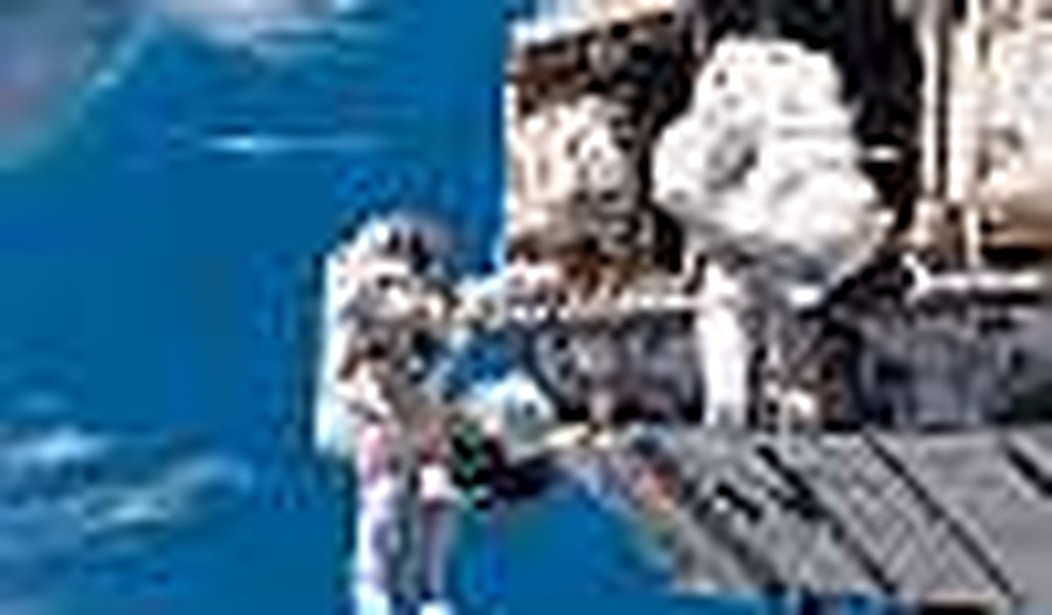As Washington reassesses its overall relationship with Russia in the wake of the recent incursion into the former Soviet Republic of Georgia, our current space policy may be dramatically affected. Given how crucial the Russians are to supporting it, particularly after the planned Shuttle retirement in 2010, we may have to decide how much the International Space Station (ISS) is really worth to us.
NASA had big problems with ISS support and its plans for returning to the moon before the latest events, but this makes them much worse. It is the result of flawed U.S. space policy going back decades — back to the original decision to develop the Space Shuttle and make it the sole U.S. means of delivering astronauts to and from orbit. Though it should have been obvious in prospect, we first discovered the folly of this policy in 1986, when Challenger was lost and we didn’t fly the Shuttle for almost three years. Fortunately, we didn’t have a space station at the time, and it wasn’t crucial to send American astronauts into space. But we didn’t learn the lesson and develop a backup system to give our space transportation infrastructure some resiliency.
In early 2003, with the loss of Columbia, the consequences were more dire, because the ISS was partially assembled in orbit with crew aboard. During that two-and-a-half-year shutdown, we were totally reliant on the Russians for resupply and crew transfer, using their Soyuz and Progress vehicles until the system returned to flight in mid-2005 and resumed assembly operations. In 2004, recognizing that the Shuttle would never achieve its original goals of low-cost, safe, frequent operations, a new policy was put into place that was intended to not only replace it, but to expand NASA’s reach beyond low earth orbit once again, for the first time since the end of Apollo a third of a century ago. In this new “Vision for Space Exploration,” the Shuttle was to be retired in 2010, after completion of the ISS, and the new system was to be ready in 2011.
Unfortunately, a combination of inadequate budgets and what many believe to be flawed and risky technical choices on NASA’s part have delayed the first flight of the new system to 2015, creating a half-decade “gap” in American human spaceflight that has alarmed many in Congress, though not enough (at least to date) for them to actually do anything about it. While NASA has been spending billions on its new single-point solution (and like the Shuttle, potential failure), the agency has been hedging its bets with a few hundred million for the Commercial Orbital Transportation Services (COTS) program, to encourage new providers, specifically Space Exploration Technologies (SpaceX) and Orbital Sciences Corporation, to develop new launch services, but so far only for cargo. The so-called COTS D program, which would purchase passenger tickets from the private sector, and in theory reduce or eliminate the dreaded “gap,” remains unfunded. Moreover, only SpaceX is developing the necessary capsule to provide such a service, and it just suffered its third straight launch failure, with no successes so far, a couple weeks ago.
So, absent some dramatic change in policy, the table is set for potential dependence on the Russians for at least five years starting in 2010. This is further complicated by the fact that in order for NASA to purchase Soyuz flights, they need Congress to grant them a waiver to the Iran Non-Proliferation Act, of which the Russians are believed to be in continual violation. Absent this waiver, it would be illegal for the agency to continue to use the Russian taxi service.
This is truly ironic on multiple levels, because politically, the only reason that the ISS even exists is that the Clinton administration decided back in 1993 to make it a joint project with the Russians, who were viewed as a “strategic partner” at the end of the Cold War. Its budget only passed the House by one vote in that year, and absent White House support, it would almost certainly have ended then. The idea was to provide funding to Russian scientists and engineers to help us with our space program, in the hope of discouraging them from selling their expertise and hardware to people like the North Koreans and Iran’s mullahs — a notion that some wags characterized as “midnight basketball for the Russians.” It clearly didn’t work.
This all was the situation before Russia’s latest apparent belligerence (and duplicity, with the numerous false “cease fires”).
With the recent events in the Caucasus, the scales have finally fallen from the eyes of many in both the administration and Congress who had previously continued to delude themselves that Vladimir Putin’s thugocracy was a “strategic partner.” In that sense, it is similar to the Soviet invasion of Afghanistan in 1979, which resulted in (among other things) the western boycott of the 1980 Olympics in Moscow.
The most immediate issue on which it’s interesting to speculate is the social atmosphere aboard the ISS this week. Interestingly, while all three of the current station crew on Expedition 17 have Russian(ish) names, and two of them are employed by the Russian space agency, none of them are necessarily Russian. The station commander, Sergei Volkov, is a Ukrainian, and flight engineer Oleg Kononenko is from Turkmenistan. Greg Chamitoff, NASA’s representative, was born in Canada. Neither of the two former Soviet Republics (and presumably, their citizens) are likely to view the Russian actions with favor, given that they could be next. Thus, given the absence of actual Russians aboard, there’s no obvious current reason for strained orbital relations, at least for now.
Back on earth, though, will be a different story. The likelihood that Congress will again waive the non-proliferation act for new Soyuz flights when the current contract expires in 2011, while never high, has probably just plummeted. And even if we were willing to continue to purchase flights, it’s quite conceivable that Russia will charge extortionate fees as retaliation for whatever other sanctions we impose as a result of the Georgian aggression. In either case, it means that if the Shuttle is really retired on schedule, the U.S. will have no politically affordable means of accessing the station into which we have poured tens of billions of dollars. In this area, the leverage currently lies with the Russians — we need them more than they need us.
So what are the options?
The most tempting one, particularly for Florida politicians, will be to simply continue to fly the Shuttle past 2010. This will have budgetary impacts, because it costs at least three billion per year to maintain the Shuttle work force and infrastructure (regardless of flight rate), and that isn’t currently accounted for in the agency’s out-year budgets. It will not only take resources from the planned development of Ares/Orion, but will also delay the necessary pad modifications needed for the new vehicle, which is planned to use Shuttle launch facilities. There is also concern that the system will have to be “re-certified” for use past that period (though no one really knows what this even means when you consider it was never “certified” in the first place). An argument could be made that this already occurred in the thorough technical scrubbing that took place after the destruction of Columbia.
One other critical and urgent issue is that the production lines for Shuttle hardware are being shut down (including external tank production in Michoud, Louisiana later this month), and restarting them later may prove to be quite expensive, so decisions need to be made now to keep this option open.
A second option is to simply abandon the ISS, or leave it to the current foreign partners — Europe, Japan … and Russia. The European ATV can do resupply on an Ariane launcher, but they would still be reliant on the Russians for crew change out. They might even invite the Chinese to participate, with their new crew launcher. This course would probably be politically unpalatable to the U.S. government, given the many tens of billions in investment by the U.S. taxpayer and the fact that a major reason to have a space station is for national prestige.
A third one is to accelerate development of alternatives, such as the SpaceX Dragon capsule, launched either on that company’s planned Falcon 9 launcher or on a Lockheed-Martin Atlas V. This will require a dramatic increase in funding, particularly if the Atlas RD-180 main engines have to be manufactured in the US by Pratt & Whitney, rather than the current practice of buying them from the Russians. Bob Bigelow is already working these issues for his own private space stations, and further funding could make it happen sooner.
None of the choices are easy or obvious. They will all involve high costs in either taxpayer dollars or lost opportunities, at a time of burgeoning deficits when there are no federal dollars to spare.
Probably most at risk are NASA’s planned Ares launchers and Orion crew module, their proposed implementation of the president’s vision for lunar and solar-system exploration by humans. Already overweight, with many unresolved technical issues, cost increases, and schedule slips, the political pressure will be overwhelming to review and overhaul the current plans. The internal contradictions of our schizophrenic civil space policy have been straining at it for years. It’s almost certain that the most recent international events will take it well past the breaking point.
Almost exactly half a century after the passage of the Space Act that created the space agency, we can only hope that we’ll finally get a rational rethink of how we plan to actually open the frontier, with an emphasis on commercialization and free enterprise, and redundancy, rather than another fragile and expensive centralized government solution. Unfortunately, if history is any guide, it’s hard to be very hopeful.









Join the conversation as a VIP Member